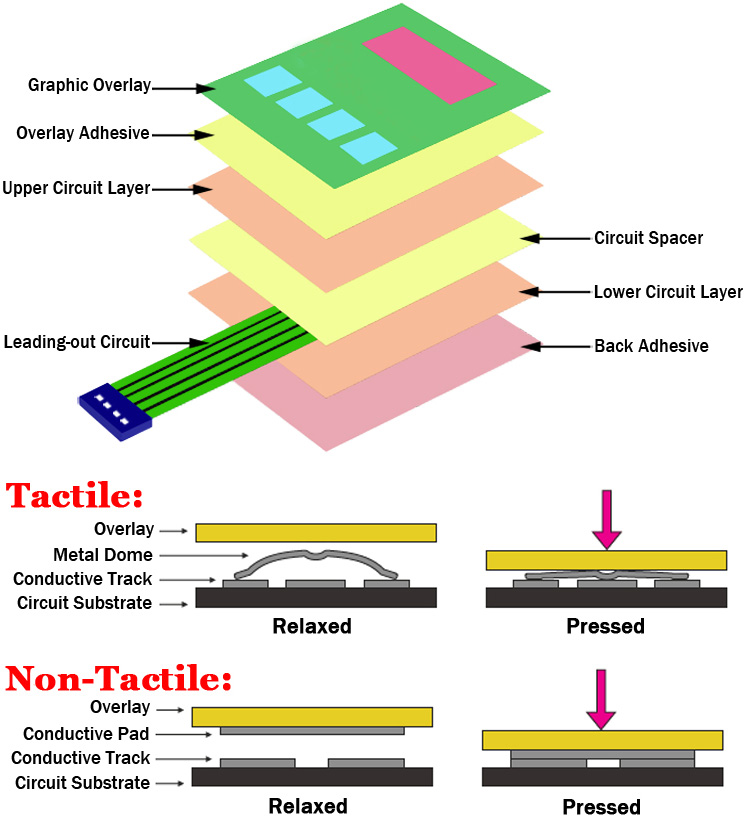The Manufacturing Process Behind Membrane Layer Change: What You Required to Know
The manufacturing procedure behind membrane switches over combines careful layout, product selection, and quality assurance. It begins with recognizing the complexities of membrane layer switch style and advances through different phases, including product choices and printing methods. Each stage plays a vital role in making certain performance and longevity. Nevertheless, the intricacies of layer construction and the extensive screening standards might reveal insights that are not quickly apparent. What exists past these fundamental elements?
Recognizing Membrane Change Layout
Although membrane switches may appear basic at initial glance, their design includes complex factors to consider that assure functionality and sturdiness. The design process begins with a comprehensive understanding of individual demands, including the interface's designated application and environmental elements. Functional designs is a crucial aspect, as the design should help with simplicity of use while guaranteeing that tactile feedback fulfills customer expectations.Moreover, the layering of elements, such as visuals overlays, adhesive layers, and conductive traces, need to be precisely engineered. membrane switch. This split configuration not only influences the switch's responsiveness yet additionally affects its durability. Attention is provided to the securing methods employed to protect versus dampness and dust, which could endanger efficiency. Furthermore, design factors to consider include looks, where color pattern and aesthetic clarity boost individual experience. Ultimately, the layout of membrane switches equilibriums capability, individual experience, and sturdiness, guaranteeing that they fulfill the needs of numerous applications efficiently
Products Utilized in Membrane Layer Change Production
When selecting products for membrane button manufacturing, it is necessary to consider both performance and sturdiness. The main products consist of polyester and polycarbonate movies, which supply adaptability and toughness. These films are commonly coated with sticky to assure appropriate bonding to substratums. Conductive inks, normally composed of silver or carbon, are important for producing electric connections within the button, enabling trusted operation.Additionally, a safety layer, such as a hard layer, is regularly related to enhance scratch resistance and longevity. The option of backing material, such as acrylic or foam, can considerably impact the button's responsive feeling and overall customer experience. Numerous environmental variables, including temperature and moisture, ought to guide product option to ensure peak efficiency in specific applications. Eventually, the right mix of materials adds to the membrane layer switch's functionality and lifespan, making notified options vital for manufacturers.
The Printing Process: Creating Graphics and Text
The printing process in membrane layer button production plays a substantial duty in producing top notch graphics and text. Different graphic design techniques are utilized to guarantee aesthetic charm and performance, while mindful ink choice approaches are essential for durability and performance. Comprehending these aspects is fundamental for achieving finest results in membrane switch style.
Graphic Style Techniques
Graphic design methods play a necessary function in the printing procedure of membrane switches, as they specify just how graphics and message will inevitably appear on the last item. Reliable visuals style includes the tactical use font styles, designs, and colors to improve readability and aesthetic allure. Designers typically use vector graphics for scalability, guaranteeing that photos stay sharp at numerous dimensions. Furthermore, focus to contrast and alignment is vital, as it affects customer communication and aesthetic high quality. The incorporation of branding components, such as logos, need to be handled with care to preserve brand name integrity. On the whole, thoughtful visuals design strategies add significantly to the capability and good looks of membrane layer switches, affecting customer experience and item efficiency.
Ink Selection Techniques
Picking the proper ink is necessary for accomplishing the wanted visual top quality and durability in membrane layer switch production. Different ink types are utilized, consisting of solvent-based, water-based, and UV-curable inks. Each kind offers distinct characteristics, such as resistance, bond, and flexibility to ecological aspects. Solvent-based inks are usually favored for their sturdiness and dynamic shades, while water-based inks are much more eco-friendly however may have constraints in bond. UV-curable inks give fast treating and durable performance. In addition, color matching strategies ensure that the picked inks line up with design specifications. Eventually, the option of ink need to take into consideration aspects such as application approach, substrate compatibility, and end-use needs to accomplish superior cause membrane button graphics and message.
Layer Building And Construction and Assembly

Material Option Process
A careful choice of products is vital in the manufacturing process of membrane switches, as it directly influences functionality and longevity. The main materials made use of include polyester, polycarbonate, and numerous conductive inks. Polyester is usually favored for its exceptional resistance to chemicals and abrasion, making it appropriate for extreme environments. Polycarbonate, on the various other hand, provides remarkable clarity and influence resistance, which is helpful for applications calling for presence and toughness. Conductive inks, typically made up of silver or carbon, are vital for producing reputable electric paths. Furthermore, the choice of adhesive products affects the overall stability of the switch - membrane switch. Evaluating variables such as ecological direct exposure, tactile responses, and visual needs guides makers in picking the most effective materials for their specific applications
Layer Adhesion Methods
Sticking layers in membrane switch building is a crucial process that assures capability and longevity. Different bond strategies are employed to protect ideal bonding between layers, which commonly include using adhesives, heat, and pressure. Pressure-sensitive adhesives (PSAs) are commonly used for their convenience of application and immediate bonding abilities. In addition, thermal bonding strategies can be applied, where warmth is made use of to trigger glue residential properties, protecting a strong bond. The choice of attachment technique mostly relies on the products involved and the details application needs of the membrane layer switch. Correct positioning and uniform application of adhesives are important to protect against defects, safeguarding the switch operates successfully throughout its designated lifespan.
Quality Assurance Measures
Ensuring quality assurance during the layer building and setting up of membrane switches is necessary for preserving performance and integrity. This procedure normally includes several crucial steps, including thorough examinations at each phase of manufacturing. Manufacturers utilize innovative screening methods, such as peel tests and bond analyses, to confirm the integrity of layer bonds. Furthermore, visual examinations are conducted to recognize any problems in printing or product incongruities. Ecological conditions, such as temperature level and humidity, are very carefully monitored to ensure excellent curing and bond. Furthermore, routine calibration of equipment aids keep specific production standards. By applying these top quality control procedures, suppliers can considerably decrease the risk of item failing, assuring that the final membrane layer switches over satisfy the required requirements and consumer assumptions.
Examining and Top Quality Control Measures

Advancements in Membrane Layer Switch Over Modern Technology
As developments in innovation proceed to progress, membrane buttons are profiting from ingenious growths that boost their capability and individual experience. One significant technology is the combination of capacitive touch modern technology, which enables more instinctive and receptive customer interfaces. This change not just enhances aesthetics yet additionally lowers mechanical damage, extending the life-span of the switches.Additionally, developments in graphic overlay materials have actually led to enhanced longevity and resistance to ecological factors such as dampness and UV light. These products now use improved clarity and brightness, more raising the aesthetic appeal.Furthermore, the consolidation of smart technology is changing membrane switches over right into interactive control board, making it possible for connectivity with site link IoT devices. This connectivity promotes a seamless user experience, leading the way for applications in different industries, from health care to consumer electronic devices. Collectively, these advancements placement membrane changes as vital elements in modern gadget design.
Often Asked Questions
For how long Does the Membrane Layer Switch Manufacturing Process Take?
The duration of the membrane layer switch production process can differ substantially. Variables such as intricacy, products utilized, and production volume impact timelines, with common production ranging from a couple of days to several weeks for completion.
What Are the Usual Applications for Membrane Layer Buttons?
Membrane layer switches are commonly used in numerous sectors, consisting of vehicle controls, household devices, clinical devices, and consumer electronics (membrane switch). Their convenience and sturdiness make them ideal for applications calling for easy to use interfaces and reliable performance in diverse atmospheres
Can Membrane Layer Switches Over Be Customized for Specific Requirements?

What Is the Life expectancy of a Regular Membrane Change?
The lifespan of a normal membrane switch differs, however normally, it varies from 1 to 5 million cycles. Factors such as use, setting, and worldly quality greatly affect sturdiness and overall efficiency with time.

Are Membrane Layer Switches Ecologically Friendly?
The ecological friendliness of membrane switches over varies. Some products utilized may not be recyclable, while others can be environment-friendly. The total impact depends upon producing methods and materials, requiring mindful factor to consider during option and disposal. The manufacturing see this process behind membrane layer changes combines mindful layout, material choice, and quality control. It starts with understanding the complexities of membrane layer switch style and proceeds with various stages, including product options and printing methods. When picking products for membrane layer button production, it is vital to ponder both efficiency and resilience. A careful option of products is crucial in the manufacturing process of membrane layer buttons, as it straight affects capability and toughness. The option of attachment technique mainly depends on the materials entailed and the certain application demands of the membrane layer button.